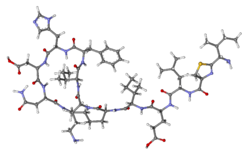Bacitracin
Polypeptide antibiotic From Wikipedia, the free encyclopedia
Bacitracin[1] is a polypeptide antibiotic. It is a mixture of related cyclic peptides produced by Bacillus licheniformis bacteria, that was first isolated from the variety "Tracy I" (ATCC 10716) in 1945.[2] These peptides disrupt Gram-positive bacteria by interfering with cell wall and peptidoglycan synthesis.
 | |
 | |
| Clinical data | |
|---|---|
| Trade names | Baciguent, Baciim, others |
| AHFS/Drugs.com | Monograph |
| Pregnancy category |
|
| Routes of administration | Topical, intramuscular, Ophthalmic drug administration |
| ATC code | |
| Legal status | |
| Legal status | |
| Identifiers | |
| |
| CAS Number | |
| PubChem CID | |
| DrugBank | |
| ChemSpider | |
| UNII | |
| KEGG | |
| ChEBI | |
| ChEMBL | |
| Chemical and physical data | |
| Formula | C66H103N17O16S |
| Molar mass | 1422.71 g·mol−1 |
| 3D model (JSmol) | |
| |
| |
| (what is this?) (verify) | |
Bacitracin is primarily used as a topical preparation, as it can cause kidney damage when used internally.[3] It is generally safe when used topically, but in rare cases may cause hypersensitivity, allergic or anaphylactic reactions, especially in people allergic to neomycin.[4][5]
In 2022, it was the 323rd most commonly prescribed medication in the United States, with more than 100,000 prescriptions.[6]
Medical uses

Bacitracin is used in human medicine as a polypeptide antibiotic and is "approved by the US Food and Drug Administration (FDA) for use in chickens and turkeys," though use in animals contributes to antibiotic resistance.[7]
As bacitracin zinc salt, in combination with other topical antibiotics (usually polymyxin B and neomycin) as an ointment ("triple antibiotic ointment," with the brand name Neosporin), it is used for topical treatment of a variety of localized skin and eye infections, as well as for the prevention of wound infections. A non-ointment form of ophthalmic solution is also available for eye infections.[8]

Spectrum of activity and susceptibility data
Bacitracin is a narrow-spectrum antibiotic. It targets Gram-positive bacteria, especially those that cause skin infections. The following represents susceptibility data for a few medically significant microorganisms.[9]
- Staphylococcus aureus – ≤0.03 μg/mL – 700 μg/mL
- Staphylococcus epidermidis – 0.25 μg/mL – >16 μg/mL
- Streptococcus pyogenes – 0.5 μg/mL – >16 μg/mL
Mechanism of action
Bacitracin interferes with the dephosphorylation of C55-isoprenyl pyrophosphate, and a related molecule known as bactoprenol pyrophosphate; both of these lipids function as membrane carrier molecules that transport the building-blocks of the peptidoglycan bacterial cell wall outside of the inner membrane.[10]
History
Bacitracin was isolated by Balbina Johnson, a bacteriologist at the Columbia University College of Physicians and Surgeons.[11] Its name derives from the fact that a compound produced by a microbe in young Margaret Tracy's (1936–1994)[12] leg injury showed antibacterial activity.[13]
One strain isolated from tissue debrided from a compound fracture of the tibia was particularly active. We named this growth-antagonistic strain for the patient, "Tracy I." When cell-free filtrates of broth cultures of this bacillus proved to possess strong antibiotic activity and to be non-toxic, further study seemed warranted. We have called this active principle "Bacitracin.[11]
Bacitracin was approved by the US FDA in 1948.[14]
Synthesis
Bacitracin is synthesised via nonribosomal peptide synthetases (NRPSs), which means that ribosomes are not directly involved in its synthesis. The three-enzyme operon is called BacABC, not to be confused with BacABCDE of bacilycin synthesis.[15]
Composition
Bacitracin is composed of a mixture of related compounds with varying degrees of antibacterial activity. Notable fractions include bacitracin A, A1, B, B1, B2, C, D, E, F, G, and X.[16] Bacitracin A has been found to have the most antibacterial activity. Bacitracin B1 and B2 have similar potencies and are approximately 90% as active as bacitracin A.[17]
Society and culture
Controversies
Claims that bacitracin is a protein disulfide isomerase inhibitor are disputed by in vitro studies.[18][19]
References
Wikiwand - on
Seamless Wikipedia browsing. On steroids.
